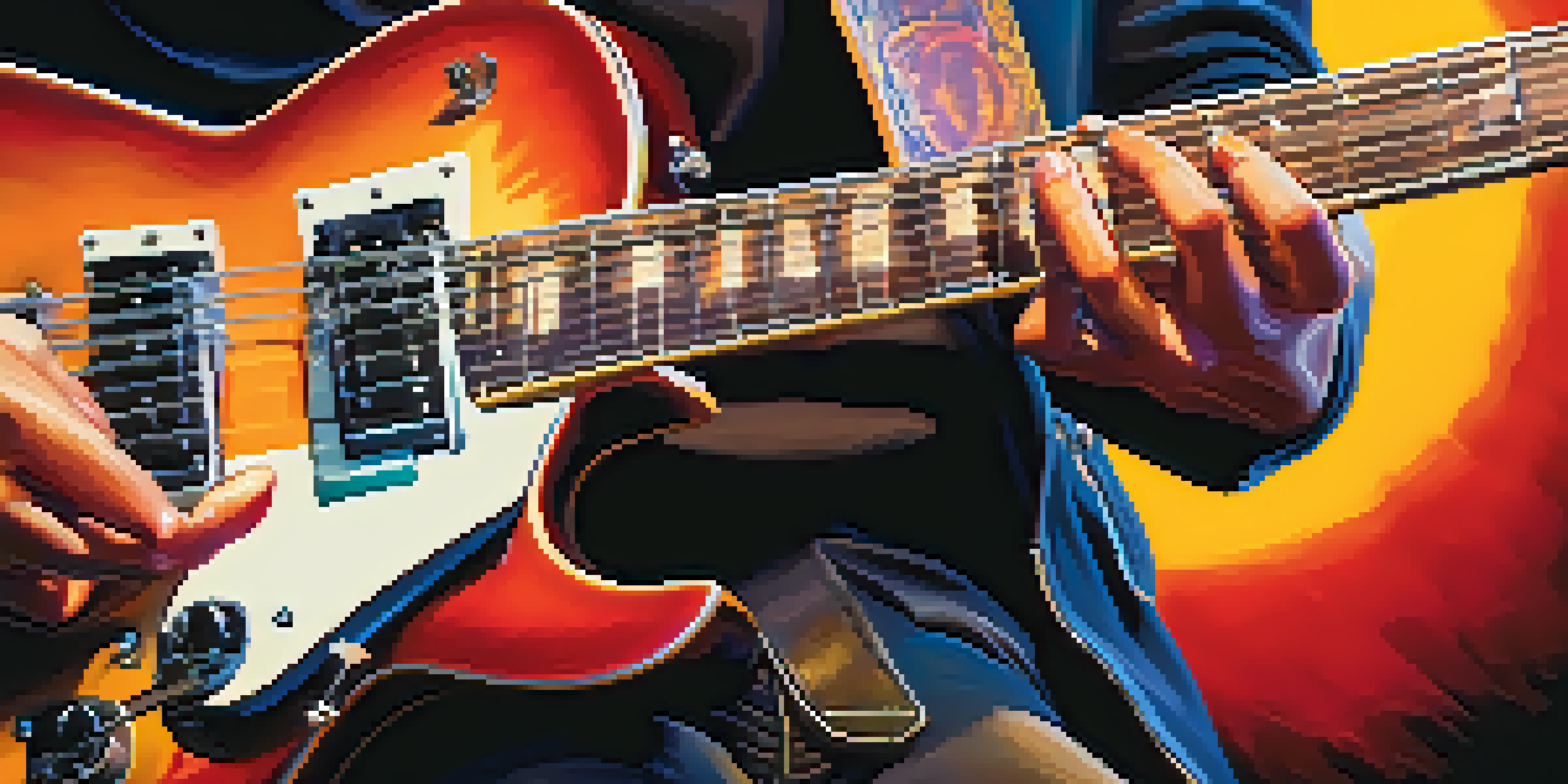Legato Exercises to Improve Your Guitar Soloing Skills

Understanding Legato: The Key to Smooth Playing
Legato is a technique that allows notes to flow seamlessly into one another, creating a smooth, connected sound. Think of it as a musical glue that binds your notes, making your solos sound more fluid and expressive. By mastering legato, you can elevate your guitar playing from good to great, captivating your audience with a more polished performance.
Music is the shorthand of emotion.
This technique is particularly beneficial for soloing, where clarity and emotion are paramount. When you play legato, you not only improve your speed but also enhance your phrasing, making it easier to convey the feelings behind your music. It's like painting with a brush rather than using a stencil; the results are much more vibrant and full of life.
To harness the power of legato, you'll need to incorporate specific exercises into your routine. These exercises will help develop your finger strength and coordination, ensuring that each note rings out clearly while transitioning smoothly to the next. So, let’s dive into some effective legato exercises that will take your guitar solos to the next level.
Basic Legato Exercise: The Hammer-On
One of the foundational legato techniques is the hammer-on, which involves striking a note and then using another finger to 'hammer' down on a higher note without picking again. This simple yet powerful technique allows you to create a fluid sound, making your solos feel more dynamic. For beginners, practicing hammer-ons can significantly enhance finger dexterity and strength.

Start by playing a note on the low E string, then hammer on to the next fret with your index finger. As you become comfortable, increase the distance between the notes and experiment with different strings. You'll notice that with practice, your hammer-ons will become cleaner and more pronounced, allowing you to express yourself more freely in your solos.
Legato Enhances Musical Expression
Mastering legato techniques like hammer-ons and pull-offs allows guitarists to create smooth, fluid melodies that convey deeper emotions.
Incorporating hammer-ons into your practice routine is essential. Aim for a mix of slow and fast tempos, focusing on clarity and precision. This exercise not only builds confidence but also lays the groundwork for more advanced legato techniques.
Mastering Pull-Offs for Enhanced Fluidity
Pull-offs are another essential aspect of legato playing, allowing you to transition from one note to another by 'pulling off' your finger rather than picking. This technique contrasts with hammer-ons and adds variety to your playing style. Imagine a waterfall, where one note flows effortlessly into the next; that’s the beauty of pull-offs.
The beautiful thing about learning is that no one can take it away from you.
To practice pull-offs, start with a simple combination of notes on the G string. Play the first note with your finger and then pull off to the lower note, ensuring that the sound remains clear and resonant. As you get comfortable, increase the tempo and incorporate pull-offs into your solos, creating a more intricate melodic line.
Combining pull-offs with hammer-ons can lead to stunning variations in your playing. As you experiment with different sequences, you'll find that your solos start to take on a life of their own. So, keep practicing and watch how your fluidity improves over time.
Combining Hammer-Ons and Pull-Offs: The Legato Flow
Once you've got the hang of hammer-ons and pull-offs, it's time to combine them for a more complex legato flow. This combination allows you to create intricate patterns that can elevate your solos and showcase your technical prowess. Think of it as weaving together strands of melody to form a beautiful tapestry.
Begin by practicing simple sequences that alternate between hammer-ons and pull-offs. For example, you might play a series of notes on one string, alternating techniques as you ascend and descend. This exercise not only enhances your finger agility but also teaches your ears to recognize the unique sound of legato playing.
Practice Consistency is Key
A structured practice routine focused on legato exercises is essential for developing proficiency and tracking progress over time.
As you grow more comfortable, challenge yourself with faster tempos and varied rhythms. You'll start to develop a unique voice in your playing that sets you apart from others. Remember, the goal is to maintain clarity and emotion in your expressions, so take your time and enjoy the process.
Incorporating Legato into Scales and Modes
Legato techniques shine when applied to scales and modes, transforming basic exercises into rich musical expressions. By incorporating hammer-ons and pull-offs into your scale practice, you can add depth and character to even the most straightforward patterns. It’s like adding spices to a dish; suddenly, it becomes much more flavorful.
Start with a simple major scale, practicing both ascending and descending while using legato techniques. For instance, try hammering on the first note of each scale step and pulling off the last. This practice will help you get comfortable with playing scales smoothly, making them a natural part of your soloing toolkit.
As you progress, experiment with different modes, applying legato techniques to create unique sounds. This will not only improve your technical skills but also expand your musical vocabulary, empowering you to express yourself more creatively in your solos.
Using Legato in Your Improvisation
Incorporating legato techniques into your improvisation can dramatically enhance your guitar solos. This approach allows for a more spontaneous and organic flow of ideas, capturing the essence of your musical voice. Imagine a river that flows effortlessly; that’s the kind of fluidity you can achieve with legato in your improvisation.
Start by selecting a chord progression and then experiment with using hammer-ons and pull-offs as you improvise over the chords. Focus on creating melodies that feel natural and allow your fingers to move freely across the fretboard. The more you practice, the more intuitive this process will become, and soon you’ll find yourself creating captivating solos in real time.
Incorporate Legato in Improvisation
Using legato techniques during improvisation fosters a spontaneous flow of ideas, enriching the guitarist's musical voice.
Remember, improvisation is about exploration and expression, so don’t hesitate to try out different combinations of legato techniques. As you experiment, you’ll discover new musical ideas that resonate with your personal style, making your solos more memorable.
Building a Consistent Legato Practice Routine
To truly master legato techniques, consistency in your practice routine is crucial. Just like any skill, the more you dedicate time and effort, the more proficient you’ll become. It's essential to create a structured practice schedule that focuses on legato exercises, ensuring you’re making steady progress.
Consider dividing your practice time into sections dedicated to specific legato techniques, such as hammer-ons, pull-offs, and their combinations. This focused approach will help reinforce your learning and allow you to track your improvements over time. You might also want to set achievable goals, like mastering a particular exercise within a week.

Lastly, don’t forget to listen to your favorite guitarists who excel in legato playing. By analyzing their techniques and incorporating what you learn into your practice, you’ll not only enhance your skills but also gain inspiration for your unique style. Consistency, creativity, and inspiration are the keys to unlocking your legato potential.